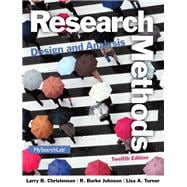Encourages mastery of the basic principles of psychological research
Research Methods, Design, and Analysis, 12/e, provides an understanding of the research methods used to investigate human thought and behavior. The coverage of experimental, qualitative, correlational, and survey research helps students develop their research skills for all aspects of psychology. Information is presented in a simple and straightforward manner and placed into context of actual research studies, helping students make real-life connections.
MySearchLab is a part of the Christensen / Johnson / Turner program. Research and writing tools, including access to academic journals, help students explore Psychological Research in even greater depth. To provide students with flexibility, students can download the eText to a tablet using the free Pearson eText app.
This title is available in a variety of formats and prices – digital and print. Pearson offers its titles on the devices students love through Pearson’s MyLab products, CourseSmart, Amazon, and more.








